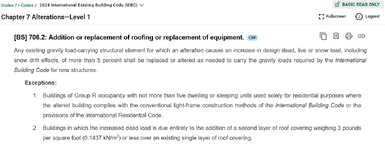As a side note, it looks like the actual text hasn't changed between 2018 and 2024. Here's the 2024 for reference, I notice the bit about current IBC in there now, I was working off brute recall.

Source: 2018-
2024 IEBC
What I'm getting at is the basic question was about what the 5% applied to, one would imagine it's load combinations, not outright loads themselves, meaning.... a 5% increase in dead load alone is "okay", because D is a load combination, [ hypothetically a roof designed for 3 psf original dead load under this exception could be allowed to take another 3 psf for a 100% increase, but let's skip that for now].
But just a 5% increase in snow or live loads would be okay because it's not a solo load combination, so D + 1.05L or D + 1.05 S, is, hypothetically, less than 5% as a resultant, (provided the dead load doesn't increase).
The situation I was considering as a counter point, where Mike Mike and I got hung up, would be a recover that changed say, the thermal coefficient resulting in an increased snow load (not the most likely scenarios, I'll grant, but where I live SLM - Snow loads matter).
Anyway, say DL = 60 psf and SL = 20 psf. (I suppose that's a Risk Category II structure where the minimum snow load governs). Anyway, 3 psf additional roofing for a recover (say 1 psf membrane and 2 psf insulation), that's 63 psf [ it LOOKS like exception 2 applies here but it really doesn't, due to the additional insulation which isn't "roof covering"]. [Brings me back to the position that the 3 psf is intended for steep slope shingles...... as no membrane itself is 3 psf that springs to mind. Not that shingle manufacturers allow this, but again, let's skip that.
If the snow load coefficient increases to 1.05 (which it really CAN'T, 1.1 to 1.2 or 1.0 to 1.1 are actual coefficients but let's skip that, too), if snow load goes from 20 psf to 21 psf, that's a 5% increase.
63/60 + 21/20 = 1.05 + 1.05 = 2 ( 1.05) = 2*2 * (1.05/2) = 1.10. Doesn't it? That's what I was getting at.
The original load combo (D+S) is 80 psf. The final load combo (D+S) is 84 psf. Which is a five percent total increase.....
What was the question again?




